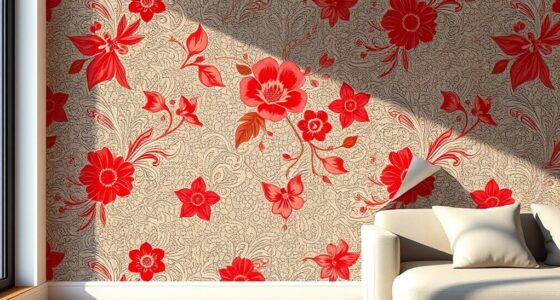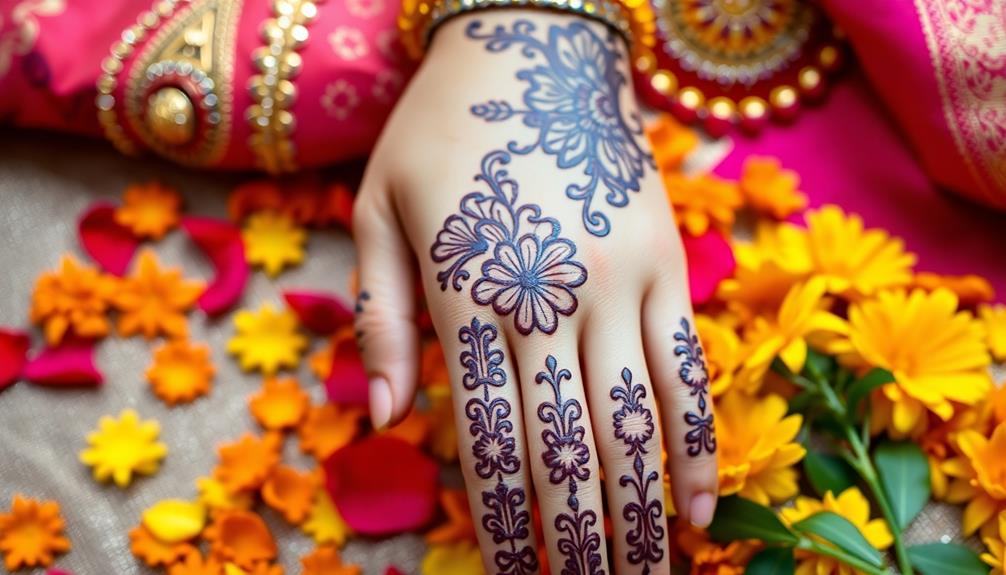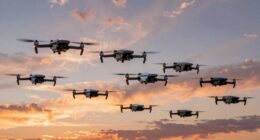To bring depth and personality to your space using batik, start with accent pillows or quilts that showcase its vibrant patterns. Upholstering dining chairs with batik fabric can make a bold statement. Try hanging batik panels as window treatments to filter light while displaying artistry. Mix batik items with solid colors for balance and layer them with natural materials for a bohemian vibe. Each batik piece is unique and rich in cultural significance, adding character that resonates with your individuality. There's so much more to contemplate to enhance your decor effectively.
Key Takeaways
- Incorporate batik accent pillows in living areas to add cultural flair and visual interest to your decor.
- Use batik quilts as throws to introduce warmth and showcase unique designs in bedrooms or common spaces.
- Upholster dining chairs with batik fabric for a bold and distinctive statement in your dining area.
- Hang batik panels as window treatments to filter light while displaying the artistry of batik designs.
- Mix batik textiles with solid colors and natural materials to create a balanced and inviting bohemian aesthetic.
Understanding Batik and Its Significance

Understanding batik and its significance begins with recognizing it as more than just a fabric decoration technique. This intricate art form utilizes wax and dye to create stunning, one-of-a-kind designs, ensuring that each piece is a unique work of art.
When you explore batik, you'll discover a little bit of history and culture woven into every thread. Batik often complements other cultural decor items, such as the Indonesian Decor Mask, to enhance the overall aesthetic of your space.
The batik process involves skillfully applying hot wax to fabric, which resists dyeing in specific areas. This technique results in distinctive patterns that reflect deep cultural and historical meanings.
As you investigate batik, you'll notice that the motifs often carry symbolic significance, tied to religious or cultural themes, making these textiles more than mere decorations; they serve as meaningful representations of heritage.
Showcasing artisan craftsmanship, each batik piece highlights the hand-painted nature, ensuring that no two items are identical. This uniqueness adds depth and character to any space in your home.
Historical Roots of Batik

Batik's journey spans over 2,000 years, rooted in ancient techniques and traditions that reflect its cultural importance across various regions.
The vibrant artistry of batik often mirrors the rich Indonesian culture, similar to how traditional artistry in masks serves as a visual narrative of local heritage.
As you explore its rich history, you'll notice how trade routes helped spread this art form, shaping the textile practices of different societies.
Each unique motif tells a story, showcasing the diverse themes that have influenced batik over the centuries.
Ancient Techniques and Traditions
How did a technique that started over 2,000 years ago continue to captivate cultures around the world? Batik's charm lies in its ancient methods, particularly the art of resist dyeing, where artists meticulously apply hot wax to fabric. This technique forms intricate patterns, preserving the fabric's original color where the wax is applied. As you explore batik's historical roots, you'll discover its journey through trade routes, spreading from Asia to various cultures and resulting in unique adaptations.
Here's a quick overview of batik's historical significance:
| Region | Historical Artifact | Year |
|---|---|---|
| Asia | Batik screens | 700 AD |
| India | Frescoes depicting batik art | Ancient |
| Middle East | Textile remnants | Various |
| Japan | Traditional garments | 8th Century |
| Indonesia | Cultural ceremonies | Ongoing |
The technique has evolved, but the core principles of applying hot wax remain unchanged. Today, batik continues to thrive in modern fashion and home textiles, reflecting its rich heritage while appealing to contemporary tastes.
Cultural Significance Across Regions
There's something enchanting about the cultural significance of batik across different regions. Originating in Asia over 2,000 years ago, batik showcases historical artifacts from places like India and the Middle East, emphasizing its long-standing importance.
As trade routes expanded, the technique flourished, allowing various cultures to create designs that reflect their unique characteristics. In Indonesian interior design, vibrant colors and intricate patterns found in batik can enhance living spaces, aligning perfectly with the cultural heritage of the region, while also offering comfort and style Indonesian Decorative Pillows.
In Japan, for instance, batik-like methods date back to around 700 AD, illustrating the art's deep roots in East Asian textile traditions. Traditional batik often incorporates symbolic motifs, which convey religious and cultural themes. Each piece serves as more than just a decorative item; it becomes a storytelling medium, connecting you to the past and the stories of those who came before.
Today, batik maintains its relevance, blending seamlessly into modern fashion and home textiles. By incorporating batik into your decor, you're not only adding depth to your space but also honoring a rich cultural heritage that spans continents.
Each design you choose tells a story, inviting dialogue and appreciation for the diverse traditions that batik represents across the globe.
The Intricate Batik Process

In the batik process, you'll see artisans skillfully apply hot wax to fabric, creating stunning designs that resist dye. This ancient technique isn't only a demonstration of cultural heritage but also reflects the rich storytelling found in each pattern, similar to the intricate designs of Indonesian decor masks.
Once the wax is set, the fabric undergoes dyeing, where it transforms through oxidation, revealing vibrant colors. This intricate method not only showcases craftsmanship but also guarantees that each piece is truly unique.
Wax Application Techniques
Batik artisans skillfully apply wax to fabric using various tools like hollow pens, brushes, and stamps, creating intricate designs that showcase their craftsmanship. Each stroke of hot wax is meticulously placed in dots and lines, allowing you to achieve unique patterns.
It's vital to avoid oversaturation, as too much wax can lead to drips and unintended designs—a mistake that can mar your artwork. This traditional technique reflects the rich cultural heritage of Indonesia, where traditional Indonesian housing often features similar intricate artistry in its architectural details.
A well-prepared workspace is fundamental for this process. With the batik technique being inherently messy, a clean area enables you to focus on your intricate designs without distractions.
The wax mixture, typically composed of paraffin and beeswax, offers flexibility during application and makes removal easier later on.
After you've applied your layers of wax and completed the dyeing process, patience is key. You'll need to carefully remove the wax using an iron and hot water.
This step often takes multiple attempts to confirm that all the wax is cleaned off, revealing the stunning patterns beneath. Each piece you create becomes a demonstration of your dedication and attention to detail, making your batik art truly one-of-a-kind.
Dyeing and Oxidation Process
The dyeing and oxidation process breathes life into your batik creations, transforming plain fabric into vibrant artwork. You start by dipping your wax-resisted fabric into dye baths. Significantly, indigo dye shifts from green to blue through oxidation as it meets the air. Each dip can yield different shades, so be patient—multiple dips may be necessary for richer colors.
Here's a quick overview of the dyeing process:
| Step | Description | Notes |
|---|---|---|
| 1. Preparation | Apply wax in intricate designs | Prevents dye absorption |
| 2. Dyeing | Dip fabric into dye baths | Indigo turns blue upon oxidation |
| 3. Rinsing | Rinse in cold water | Stops the dyeing process |
| 4. Wax Removal | Boil or iron to remove wax | Hot water aids in detachment |
After the dyeing, you'll remove the wax, revealing stunning patterns. The interplay between color and texture reflects your unique inspirations, enhancing the final appearance of your fabric. Immerse yourself in this fascinating process, and watch your batik art come alive!
Distinctive Features of Batik

Celebrating its hand-painted nature, batik brings a unique charm to home decor, as no two pieces are ever identical. The meticulous waxing and dyeing process creates distinctive patterns that capture the eye and elevate your space. Each design showcases depth and texture, enhancing the overall visual interest of your decor.
Incorporating batik into your home can also harmonize with traditional Indonesian style home decor, emphasizing natural materials and cultural significance.
Natural inspiration plays a significant role in batik, with the colors influenced by oxidation during the drying process. This results in rich, varied hues that contribute to the aesthetic appeal of each piece. Additionally, many batik patterns contain symbolic motifs that reflect cultural and historical significance, adding a narrative element that resonates with viewers.
Variations in wax application techniques lead to an impressive array of distinctive patterns and styles, accommodating diverse tastes and preferences. Whether you prefer bold, intricate designs or subtle, soft hues, batik offers endless possibilities for personal expression in your home.
Practical Ways to Incorporate Batik

Incorporating batik into your home decor can instantly elevate your space with vibrant colors and unique patterns. This eclectic approach to design allows for a personalized touch that resonates with both cultural heritage and individuality, appealing to younger generations seeking nostalgic elements.
To start, add a little personality to your living area by using batik accent pillows on your sofas or chairs. These pillows not only create a focal point but also add texture and cultural flair. You can also make sure to introduce warmth and comfort with batik quilts as throws on beds or couches, showcasing unique designs that reflect your personal style.
If you want to make a bold statement in your dining area, consider upholstering your dining chairs with batik fabric. The intricate designs will spark conversation and enhance your dining experience.
For a touch of elegance, hang batik panels as window treatments; they'll allow natural light to filter through while showcasing the artistry of the fabric.
Styling Tips for Batik Decor

Transforming your space with batik decor can evoke a sense of vibrancy and cultural richness. Start by incorporating batik accent pillows into your living room. They're going to make a striking addition, especially when mixed with solid-colored fabrics that balance the patterns.
To enhance the bohemian feel, consider layering your textiles with natural elements like wood and textiles, which can create a harmonious atmosphere. Consider using batik quilts as statement pieces in bedrooms or living areas; their intricate designs and cultural significance are sure to draw attention.
In your dining room, upholstering chairs with batik fabric is going to make a bold centerpiece that enhances the overall aesthetic with unique artistry. For your windows, hang batik panels or shades to allow the rich colors and patterns to filter light beautifully, serving as both functional and artistic elements.
This approach aligns well with Boho Above Bed Decor, adding depth and personality to your space.
Embracing the Batik Aesthetic

Batik decor isn't just about adding color; it's about embracing a rich tapestry of culture and artistry that transforms your home into a vibrant sanctuary. Each piece of batik fabric tells a story through its intricate designs, crafted with a unique wax-resist dyeing process. This means every item you choose is one-of-a-kind, giving your space a personal touch that stands out.
By incorporating batik into your decor, you can create a harmonious environment that reflects traditional craftsmanship and a connection to nature, aligning beautifully with Balinese interior design principles like blending indoor and outdoor spaces.
Incorporating batik into your home decor is an easy way to enhance visual interest. Think about accent pillows or quilts with those vibrant patterns—they can serve as stunning focal points in your living room or bedroom. Plus, the historical significance of traditional batik motifs can infuse your space with depth, reflecting different cultural narratives and heritage.
Batik's versatility means you can include it in various design elements, from window treatments to upholstered furniture. By doing so, you create a cohesive and dynamic aesthetic throughout your home. Batik designs for balanced homes can bring a sense of cultural richness and elegance to any space. Whether used as a focal point or as subtle accents, batik patterns add depth and visual interest to a room while maintaining a harmonious design scheme. The intricate and unique designs of batik also make for intriguing conversation starters, adding a personal touch to your decor.
When you embrace the batik aesthetic, you're not just decorating; you're inviting organic beauty into your environment, ensuring your space is going to keep going strong with character and warmth for years to come.
Frequently Asked Questions
How Is Batik Used in Everyday Life?
Batik's used in everyday life through vibrant textiles like clothing, home decor, and accessories. You can incorporate batik in your wardrobe, create unique home accents, or gift beautiful pieces that celebrate cultural artistry and craftsmanship.
What Is the Importance of Batik in Art?
You'll find batik's importance in art lies in its unique storytelling through intricate patterns. Each piece connects you to cultural heritage, showcasing craftsmanship and patience, transforming fabric into profound narratives that resonate across time and space.
How to Do Batik Technique?
To do the batik technique, you'll prepare your fabric, apply a wax mixture using a foam brush, dye it with indigo, and carefully remove the wax afterward. Patience is essential for achieving beautiful results.
Is There a Wrong Side to Batik Fabric?
There isn't really a wrong side to batik fabric. It all depends on your personal preference. The dyed side often stands out more, but the waxed side can add unique textures to your projects too.
Conclusion
By incorporating batik into your space, you're not just adding decor; you're inviting a piece of history and artistry into your home. Imagine walking into a room adorned with vibrant patterns that tell stories of cultures and traditions—doesn't that instantly transform the atmosphere? Embrace the beauty of batik to create a warm, inviting environment that reflects your personality and passion for unique design. Let every piece spark conversation and inspire creativity in your everyday life.










